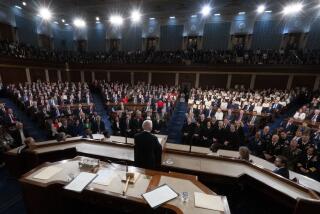Avoiding the ‘fiscal cliff’ but falling anyway
It would be bad enough if the purveyors of economic and fiscal misdirection had done no more than describe a certain event looming at the end of this year as the “fiscal cliff.”
The imagery evokes an elemental crisis that can be avoided only by the heroic efforts of our statesmen in Washington. But in fact it’s entirely their creation. The automatic tax increases and deep spending cuts could be avoided by the stroke of a pen.
But they haven’t stopped with merely applying a misleading label. They’ve aimed their rescue efforts at fiscal nostrums that do nothing to address the truly urgent economic issues facing American workers and businesses today. They’ve confined the discussion of tax reform to tweaks that will leave virtually intact the most important tax break for the wealthy (the preferential treatment of investment income), while turning their gun sights on government programs that keep millions of Americans healthy and out of poverty (think Medicare and Social Security).
Make no mistake: The valiant budget negotiators at work in Congress and the White House are mapping out a plan for economic austerity under the guise of “getting our house in order.” This is despite blindingly obvious evidence that what’s needed in the U.S. today is the opposite — more stimulus to jump-start job creation, and more spending on infrastructure from roads and bridges to communications and electrical grids.
Do you doubt that? Then look at the paragon of post-crash austerity: Europe. Harsh budget cuts in Greece, Spain, Portugal and Italy, along with austere fiscal regimes in France and Britain, have pushed the Eurozone back into recession.
Quiz: How much do you know about the ‘fiscal cliff’?
American policymakers are still talking about budget-cutting as some sort of moral imperative. Who benefits from this sort of willful blindness? Not the average job-seeking American. Most of the pain from this new regime will be inflicted on the middle class and working class.
President Obama has declared himself determined to increase the share of taxes paid by the wealthy. But he has also hinted that he might be amenable to proposals to raise taxes by ratcheting back certain deductions, such as those for mortgage interest and employer-provided health insurance.
Tellingly, one of the most important tax breaks for the wealthy never seems to be on the table: the preferential low tax rate on long-term capital gains (on assets held at least one year) and some other investment income. It’s currently 15% but scheduled to rise to 20% if the Bush tax cuts expire. Meanwhile, taxpayers who file as married couples are paying more than 20% on every dollar of wage income they report over about $79,000 this year.
If you want to know why eliminating the capital gains preference is so seldom mentioned, it’s because it’s cherished by the wealthy more than any other break. In 2011, capital income accounted for about 42% of all income collected by taxpayers earning more than $1 million, who receive two-thirds of the benefit of the cap gains tax break. For those earning between $75,000 and $100,000, capital income accounts for a measly 2.3% of earnings.
Despite the cost of this giveaway — it will be worth $440 billion over the next five years — the deficit warriors in Washington are intent on cutting Social Security and Medicare. That’s the aim of such bogus grass-roots Washington organizations as Fix the Debt and the Third Way, which agitate to pare “entitlement” benefits crucial for the middle and working class by cutting inflation adjustments and raising retirement ages.
Both of those organizations are connected to the hedge fund billionaire Peter G. Peterson, whose fiscal philosophy, characterized by hostility to those social welfare programs, has exerted outsized influence on the fiscal cliff debate.
The shibboleth that gives urgency to the fiscal cliff talks is the idea that only tax increases and spending cuts can rescue the U.S. from unsustainable deficits. “You can’t grow your way out of this,” former Sen. Alan Simpson, the Wyoming Republican appointed by President Obama as co-chair of his 2010 deficit commission, said on CNBC recently.
That sounds suitably admonitory, but it’s not quite true. The vast bulk of today’s deficits are not structural but cyclical — the result of spending designed to address the financial crisis and the Great Recession, the effects of which are still with us.
History shows that economic growth can do wonders to reduce government deficits and debt. The national debt as a ratio of GDP peaked at 120% in 1947, reflecting wartime spending. By 1958 that ratio had been cut in half, and by the end of the ‘60s by nearly half again.
Indeed, economic growth in recent quarters already has cut into the deficit as a share of GDP, bringing it down from 10%, the level it reached in the aftermath of the 2008 crash, to about 7% today. The Office of Management and Budget projects that the ratio will fall further, to about 3.2% by 2015, based on the assumption that the Bush tax cuts will expire, emergency spending will ebb, and the economy will be about 20% larger than it is today (not an unreasonable projection, providing that growth isn’t strangled by spending cuts already on the table).
Such a trend line “would likely calm widespread fears of a ‘fiscal crisis,’” economist James W. Paulsen, chief investment strategist at San Francisco-based Wells Capital Management, wrote recently. “Perhaps we do not need any Grand Bargain.”
So what’s the proper course for economic policy in the near term?
The economic record tells us that higher marginal tax rates on the wealthy have no correlation with lower economic growth. As a recent study of 65 years of data by the Congressional Research Service concluded, “The top tax rates have little or no relation to the size of the economic pie.”
On the other hand, spending cuts imposed during slumps do have a direct effect on the economy — they’re like sand in the gears of recovery. That’s the signal from Europe about the consequences of austerity, reinforced by the fragility of an American recovery insufficiently supported by government.
Yet the budget-cutting juggernaut rolls on, apparently on the principle that if you’re going to extract higher taxes from the wealthy, you have to offer in return more “sacrifices” from retirees living on Social Security, less healthcare for seniors, more transfers of crucial programs from the federal government to already strapped states and municipalities.
The Europeans must be witnessing the jockeying over the fiscal cliff with both horror and relief — horror that the U.S. is toying with falling down the same abyss as they have, and relief that they may not be down there by themselves much longer.
Michael Hiltzik’s column appears Sundays and Wednesdays. Reach him at [email protected], read past columns at latimes.com/hiltzik, check out facebook.com/hiltzik and follow @latimeshiltzik on Twitter.
More to Read
Inside the business of entertainment
The Wide Shot brings you news, analysis and insights on everything from streaming wars to production — and what it all means for the future.
You may occasionally receive promotional content from the Los Angeles Times.











